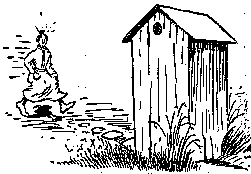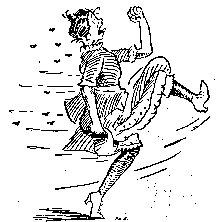|
W
hen memory keeps me company and moves to smiles or tears, A weather-beaten object looms through the mist of years, Behind the house and barn it stood, a half a mile or more, And hurrying feet a path had made, straight to its swinging door. Its architecture was a type of simple classic art. But in the tragedy of life it played a leading part. And oft the passing traveler drove slow, and heaved a sigh, To see the modest hired girl slip out with glances shy. |

|

|
W
e had our posey garden that the women loved so well, I loved it, too, but better still I loved the stronger smell That filled the evening breezes so full of homely cheer, And told the night-o'ertaken tramp that human life was near, On lazy August afternoons, it made a little bower Delightful, where my grandsire sat and whiled away an hour. For there the summer mornings, its very cares entwined, And berry bushes reddened in the streaming soil behind. |
|
A
ll day fat spiders spun their webs to catch the buzzing flies That flitted to and from the house, where Ma was baking pies, And once a swarm of hornets bold had built a palace there, And stung my unsuspecting Aunt--I must not tell you where. Then father took a flaming pole--that was a happy day-- He nearly burned the building up, but the hornets left to stay. When summer bloom began to fade and winter to carouse, We bank the little building with a heap of hemlock boughs. |

|

|
B
ut when the crust was on the snow and the sullen skies were gray, In sooth the building was no place where one could wish to stay. We did our duties promptly, there one purpose swayed the mind; We tarried not, nor lingered long on what we left behind. The torture of the icy seat would make a Spartan sob, For needs must scrape the flesh with a lacerating cob, That from a frost-encrusted nail, was suspended by a string-- My father was a frugal man and wasted not a thing. |
|
W
hen grandpa had to "go out back" and make his morning call, We'd bundle up the dear old man with a muffler and a shawl. I knew the hole on which he sat--'twas padded all around, And once I dared to sit there--'twas all too wide I found, My loins were all too little, and I jack-knifed there to stay, They had to come and get me out, or I'd have passed away, Then father said ambition was a thing that boys should shun, And I just used the children's hole 'til childhood days were done. |

|

|
A
nd still I marvel at the craft that cut those holes so true, The baby hole, and the slender hole that fitted Sister Sue, That dear old country landmark; I tramped around a bit, And in the lap of luxury my lot has been to sit, But ere I die I'll eat the fruit of trees I robbed of yore, Then seek the shanty where my name is carved upon the door. I ween the old familiar smell will sooth my jaded soul, I'm now a man, but none the less I'll try the children's hole. |
|
As always, the visitors to this site have unsurpassed knowledge. Today, 12 May 2000, I received the following Email alleging the true author to the above poem. Here is what they had to say... |
|
|
Here is yet another comment sent to me in April 2007 disputing the above comment. |
|
